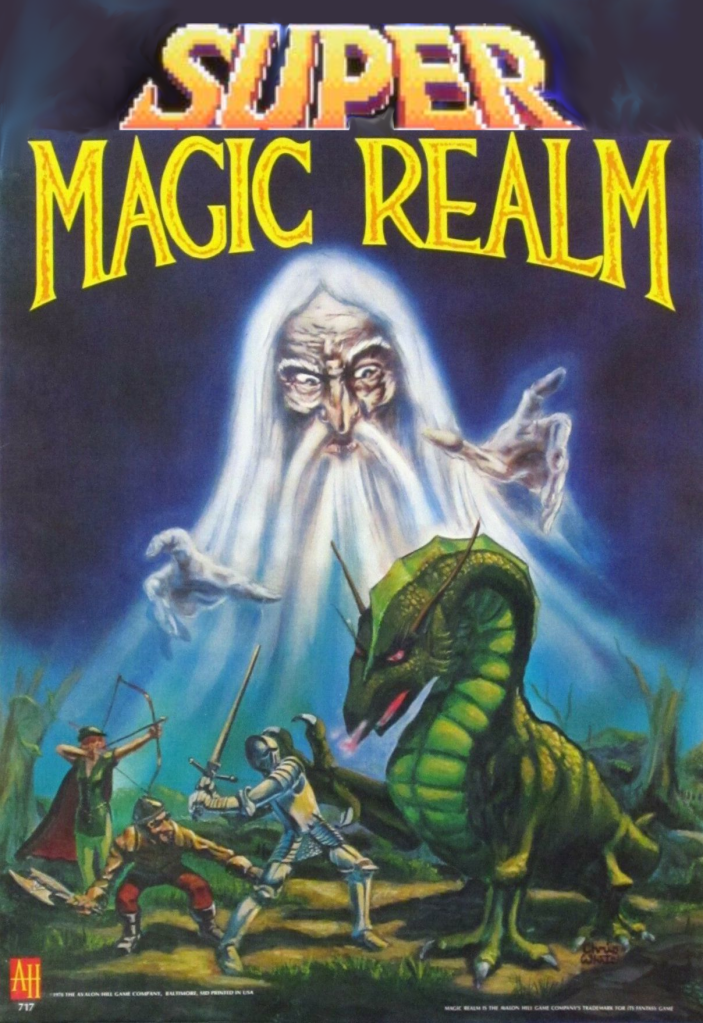
Rated: 4 / 5 (if playing with 6+ players who are good, otherwise -1 modifier to the rating)
Link to print-and-play files (zipped): https://drive.google.com/file/d/1ZM_nWesAXeMkp1FCYGU2EYitT12eZAnn/view?usp=share_link
Link to print-and-play files (non-zipped): https://drive.google.com/drive/folders/1wLsmUSeJfrzthx-b2otOeWigyNIF89sT?usp=share_link
Link to Tabletop Simulator Mod: https://steamcommunity.com/sharedfiles/filedetails/?id=1248055332
Link to BGG page: fuck that and fuck Octavian and all the other BGG mod cocksuckers who nuked my account for no good reason!
I know, I know. The gall of reviewing my own fan-expansion, especially after making a prior post that basically already covers it. Well I feel like it damnit. Plus I’d like to show that I can be critical of myself. After enough play sessions and fine-tuning, the game is finished. It’s primarily just a matter of correcting typos in the rulebook here and there at this point; plus the occasional expansion of the index. This will be less of an overview of what the expansion is (did that in the aforementioned prior post, though there have been some tweaks since then), and more of what I think is good and terrible about the system. This also takes the base game into account. In any case, this review is aimed at the expansion alone. Blunt brutal honest opinions without holding back. I can be very critical of myself.

The thing about this game… Initially there’s the whole journey of discovery, learning the system, learning the characters, how to optimally play as the characters, learn the statistics of die results, the odds of monsters showing up on certain tiles, knowing how to pick and choose your battles, when you should press your luck for going after treasures, etc. Once you get through that whole process and learn the strategies well enough, and by God you better have fun doing it (the tutorial scenarios that come with the game make it less painful, especially compared to learning the 3rd edition base game rules just from the rulebook alone), you start to realize the game gets dull. That’s not to say you’ll know everything about the game system at that point, and not be surprised every now and again when something happens that you don’t see often (or never have up until that point), but I find it’s not worth the effort to experience those moments if I’m not playing with a group.
Take this opinion with a grain of salt if you have a fancy for solitaire gaming, because with one exception, I’m not keen on solitaire board games. That exception being Fields of Fire, which was designed from the ground up to be a solo experience, and it plays pretty damn well in that regard (though that has its own learning curve, plus some serious errata issues). There’s also the solo expansion for Conflict of Heroes: Awakening the Bear (2nd/3rd edition), but that’s heavily scenario-based. And the problem with scenario-based games is once you figure out the method for winning that scenario, it loses most of the replay value for that scenario. FoF has scenarios too, but they’re nowhere near as static as those in CoH; you could play the same scenario multiple times, even after winning, and still have a fresh experience each time.
Those other games aside, Super Magic Realm (or even just the base game Magic Realm) isn’t intended for solo play. Sure it can be played solo, and it’s great for when you’re first starting out (even if the difficulty is more brutal as a result, though you could play with multiple characters if you’re up for that task), just to learn the game system. But it becomes dull afterwards. The only way it can no longer be dull is if you play with other players. Trying to find others who will play the base game is difficult enough as-is. You’re probably shit out of luck if you want to find others to play the expansion system, especially in-person if you end up making a physical copy (a daunting task, even if no 3D printing is involved). And with that in mind, the amount of players needed to make it not dull differs from the base game and the expansion. The base game (MR) can be played well-enough if you have at least 4 players (on-average). With the expansion (SMR), I find it needing at least 6 players for a decent experience on-average.
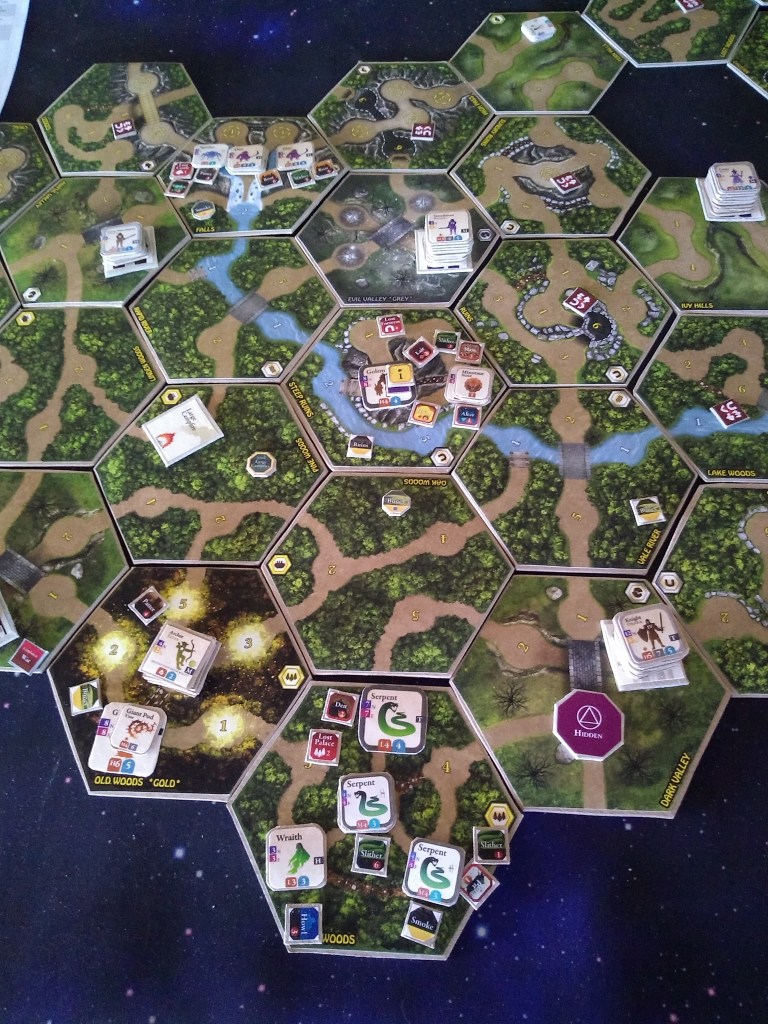
If you can manage a session (hopefully a complete one, which will likely take all day, or a weekend) with at least that many players who all know what they’re doing, then the game really starts to come alive. More than just seeing what other characters uncover in their section of the map (assuming some players split from others, or do the whole alternate start locations thing), it’s also about how the players interact with one another. At it’s core, it’s a competitive game (something the expansion puts as much emphasis on as the 1st edition rules did, which the 2nd/3rd edition rules took away from, the latter ultimately to the game’s detriment), so any deals players make with each other tend to be short term benefits for long-term gains. Which is necessary during the “first arc,” as I like to call it, of the game (more on that later). Because early on, characters are not very strong.
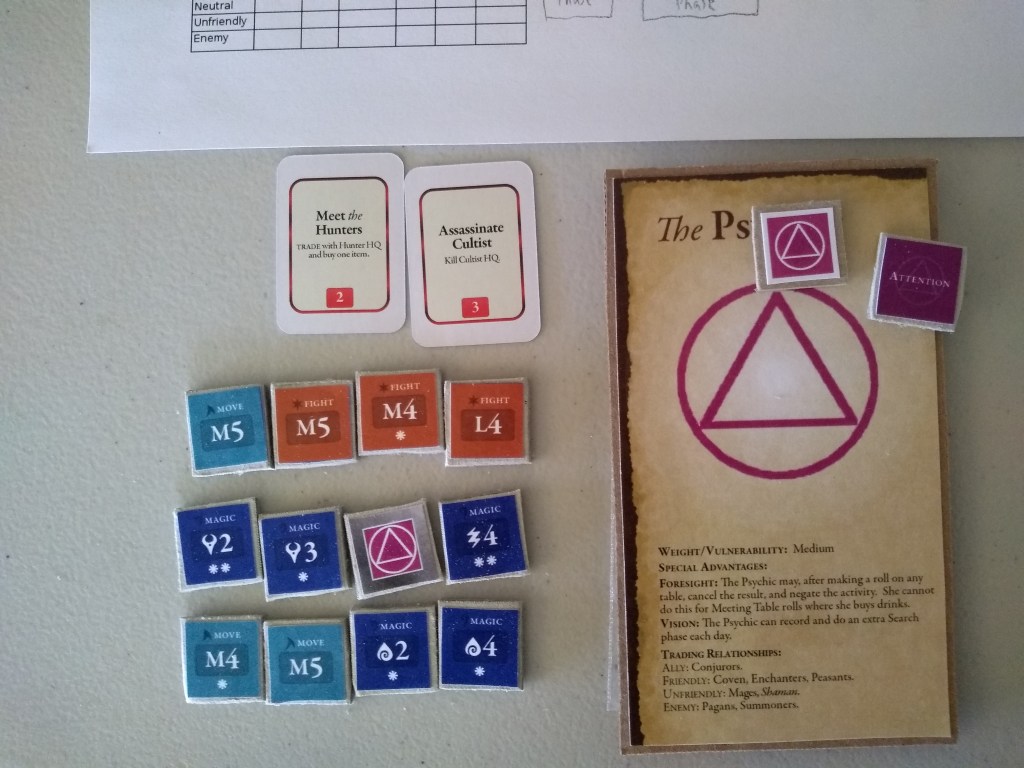
I won’t discuss how complex the combat system is in this game (I’m trying to avoid doing a glorified rules recap), other than to say it’s one of the most complex systems ever devised in a board game, and the most difficult thing to fully grasp in this game (if you can learn how combat works, everything else is a cakewalk by comparison). But I will say this: the combat system, even with the Parry and Survival Tactics stuff that’s absent in the base game (save for an optional rule in 1st edition where the Parry optional rule felt tacked-on and unnecessary, mainly because it was intended to be utilized in a 3X3 grid combat system that wasn’t ever officially implemented), is more brutal and difficult than in the base game. Not unreasonably so, characters still have decent odds against the same monsters they were good at killing in the base game. But it’s less of a certainty because of how the 3X3 system changes things from the 3X1 system. In MR, you would always attack in the same row you maneuver; there’s almost always never a need to do otherwise. Predictable and boring, and it made it easy for Fame+Notoriety point gains/combos (seriously, it’s possible to end the game with over 100 points in each of those categories easily if you’re a Heavy character with one or two hirelings, or a magic user capable of casting Absorb Essence). The 3X3 system adds more luck into it, but the way monsters can change tactics and the way the Survival Tactics system (an Advanced Rule) works brings some amount of control to the luck. The whole point being, SMR combat is a bit more luck based and difficult to win at against denizens (even when you have hirelings against denizens) compared to MR, but this isn’t a bad thing. Combat eventually felt too safe in MR. Whatever safety measures one felt MR had are removed in SMR. And because combat is more risky, this encourages making alliances with other characters. Almost as if you need them to survive. Like that will discourage characters from going off on their own to win without anyone’s help, and thus further discourage killing off other characters early on. What a concept. A natural mechanism of the game that there isn’t an explicit rule for.
MR veterans may have to adjust the strategies they’re used to accordingly, which may be frustrating initially since many are used to the lone wolf strategy I’m sure (especially if they play as a Heavy character). But encouraging player cooperation in this way is a good thing. It also allows for some interesting conversations and planning to be had during combat when teamwork is involved. Given the greater emphasis on teamwork (and thus a greater emphasis on the turn order during combat rounds for that reason) due to combat being more dangerous, this makes for more interesting conversations compared to MR. Also that trick with Absorb Essence won’t be as reliable as it used to be, at least when it comes to getting extreme combo kills, since killing denizens isn’t something that prolongs combat anymore in SMR. An exploit that needed addressing, though it’s still a powerful spell to utilize.
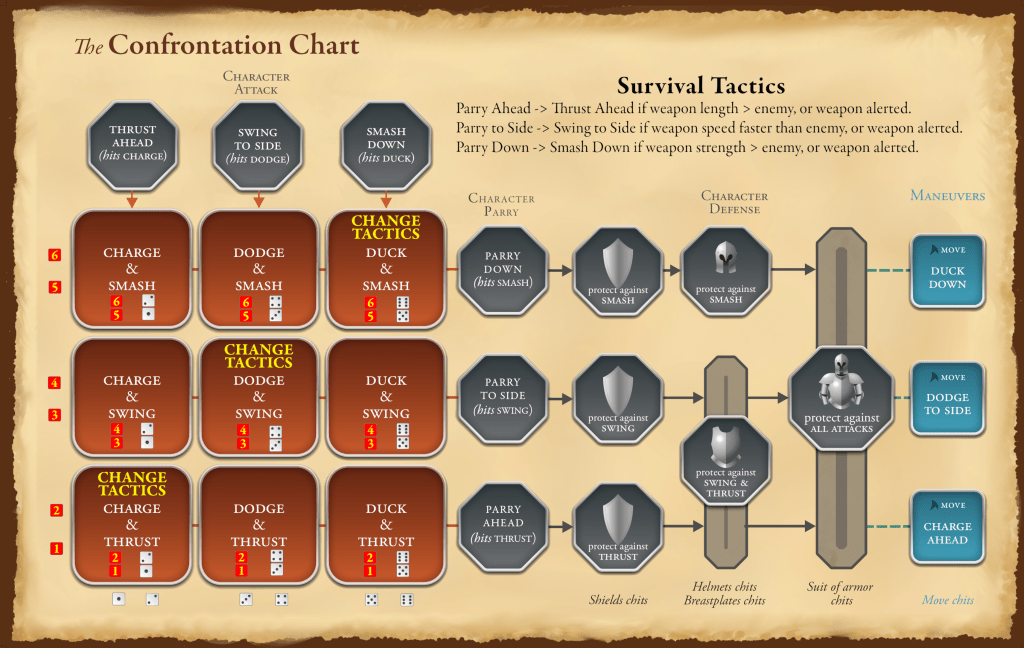
That being said, combat can get tedious too, if you have half a dozen or more denizens to deal with. MR, for all its faults (due to simplicity in tactics), did at least address this issue by just having up to 4 separate dice rolls, tops, to position everything all at once. It may have made things a bit too gamey and allowed for a little too much player control, but it also kept things more expedient as a result. With SMR, even though it streamlined combat as much as it made it more difficult, it also increased the number of dice rolls you make if going up against more than 4 denizens at once, which can definitely happen (especially with the increased number of monsters in the game). The only real way to address this problem is having other players handle the other denizen sheets, assuming they’re not also directly participating in combat in the clearing. This is only possible if all players are experienced and know what they’re doing, so having the right group for this matters.
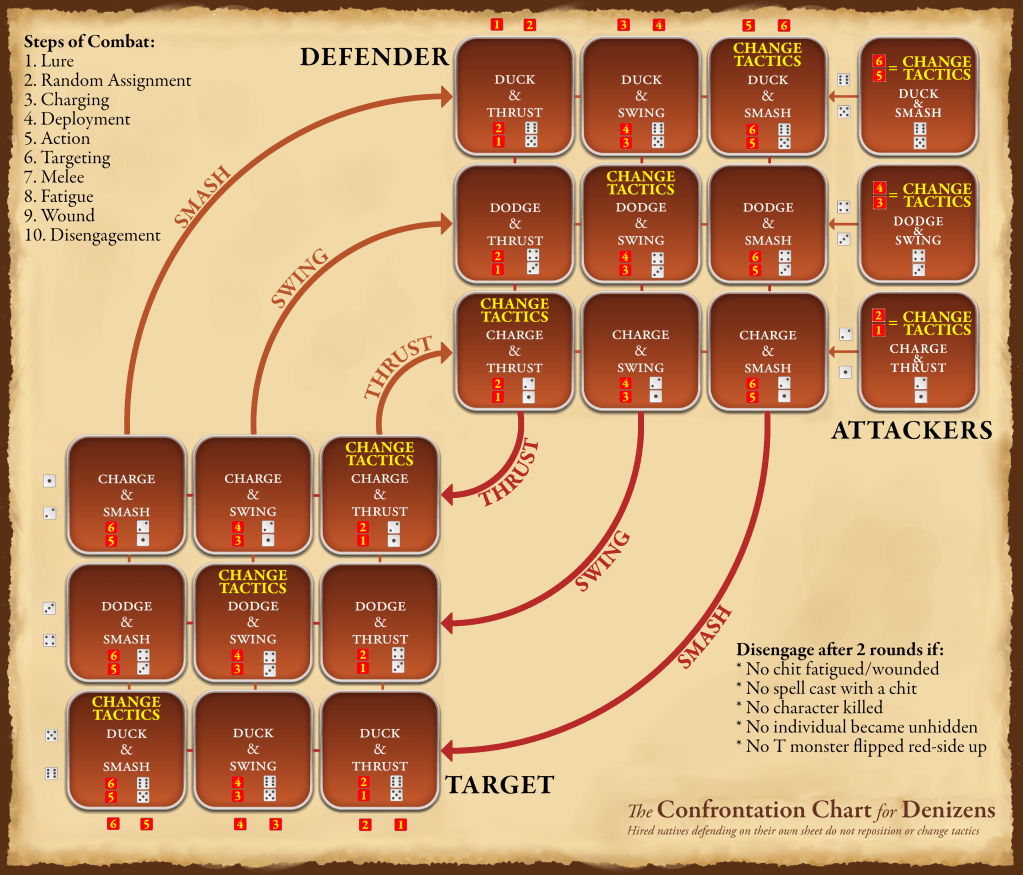
If you’re playing with 6+ players (you could still have an enjoyable experience with less, but I wouldn’t go under 4 players unless it’s a tutorial session), and it’s a good competitive gaming group with a respectable amount of intelligence and manners, the game will shine. Otherwise, it’s not going to be a great experience. I imagine that’s the case for most board games, but this game is more demanding compared to most.
And yes, the game does take longer to play due to setup alone, not to mention more VPs being distributed compared to MR (MR had 4-5 VPs you would distribute, SMR has 12 VPs distributed in a standard game, more on that later). Nothing much can really be done as far as setup time is concerned, aside from not setting everything up (leave out treasure/spell cards until they’re needed, same with map chits and travelers, etc; that drastically reduces setup). As for gameplay itself, there is an activity that can reduce the length of the game, an activity that was most certainly underutilized in the 2nd/3rd edition rules: the Follow activity. When you follow a character, you don’t really get your own turn per-se, you just partake in whatever the guide you’re following does. So if 5 characters were following one, the in-game day will play as if only one turn played for that day, as opposed to 6 separate turns. Greater emphasis is placed on Following compared to MR not just because of combat being more dangerous, not just because this would only cause monsters to move/appear as if only 1 character ended a turn on a tile as opposed to 2+ (something 2nd/3rd edition messed up compared to 1st edition), but also because there’s no “spying” or sharing/selling of site/road locations as there was in 2nd/3rd edition. The Follow activity creates benefits for that. And if you’re worried about the guide having more opportunities to loot treasures compared to other characters, again, that’s why there’s greater emphasis on teamwork and competitiveness. This creates opportunities for negotiation. If someone in the party is acquiring too much treasure, members of the party could demand a share (they made it possible to loot safely, or something). Demanding they get it for free, trade gold for it (or some other item), or threaten to leave the party, or block/attack the guide (which would end the turn and cause monsters to appear, making the situation more complicated). It’s stuff like this why the game is no longer dull when played with 6+ players who all know what they’re doing.
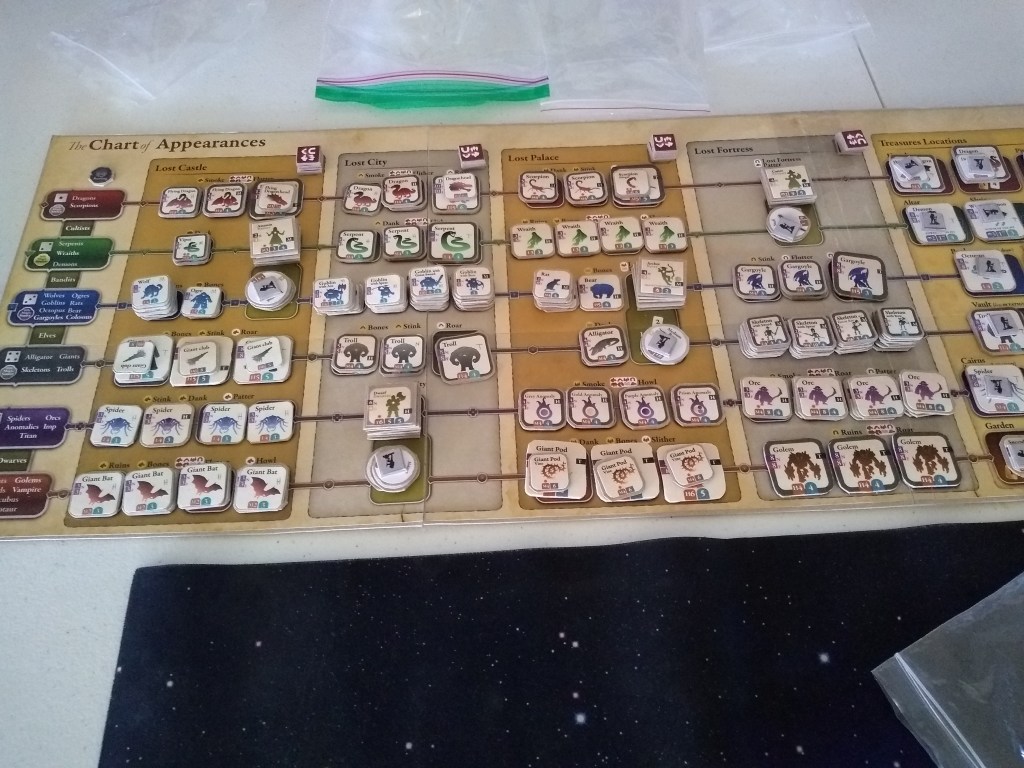
Regarding the game arcs, many great board games have this, especially 4X games like Twilight Imperium and Civilization. First there’s the alliances and discovery portion, where you band together and seek out treasure sites and/or monsters to slay. Then there’s the 2nd arc, where you have enough stuff to potentially become independent, but you need to time things right for breaking away from the party to sell stuff off to natives, and then potentially hire natives (or buy better equipment) so that you have a small army to do your bidding, or become better equipped for being a one-man army. Then there’s the 3rd arc, where players are in a mad dash against each other to get enough points to fulfill their VP conditions, even if it means killing each other off (sometimes just to kill the leader). In SMR, someone who has fulfilled their conditions can opt to leave the map early on (if their character is in a position on the map to do so, somewhere near the edge), which means they’re safe and their points are locked in, but the other players can continue on for the remainder of the month to gain enough VP to surpass that of the character who left the map. However, if he left the map at, or near the end of, the month, well then there’s that much less time for other characters to accumulate points (by getting treasures, killing things, learning spells, trading, etc).
Speaking of VPs, the increased VP distribution amount is a pro and a con in SMR. On the one hand, despite the higher amount of assigned points, it also allows for more leeway due to being able to remove assigned VP by completing quests, discovering sites (and TWTs), and other stuff. It’s fun and all, but the con is that it seems less significant compared to MR (even if the VP system got stale real fast in that game; most characters would only need VP assigned in Notoriety and Fame, and nothing else). You could put 2-3 VP in everything, and discover sites to deduct the VP from where you don’t need it, which puts more emphasis on discovering stuff and less on deciding a strategy from the start (which gives you more reason to follow someone who can discover stuff for you). Granted, circumstances can arise which could cause certain VP distributions to backfire; plus a player group that is familiar with the game and with everyone in the group can anticipate things and know how to plan/play more optimally which could put greater emphasis on distributing the points in a certain way for the sake of efficiency. Regardless, it still seems like a weak point in the game system, for a completely different reason than in MR. It doesn’t make the game bad or anything, as interesting situations can arise depending on VP assignment and deduction, seeing what could cause you to change your game strategy (coming across a treasure, or somehow getting lucky enough in combat to get an insane combo of Fame/Notoriety, or acquiring spells more quickly than you would expect). It’s just not as strong as I would like it to be. The emphasis is more on, “what points should I be deducting,” during the mid-game as opposed to having greater emphasis on, “how should I be distributing the points.” While I do consider this an improvement over MR, it doesn’t improve it as much as I would’ve liked.
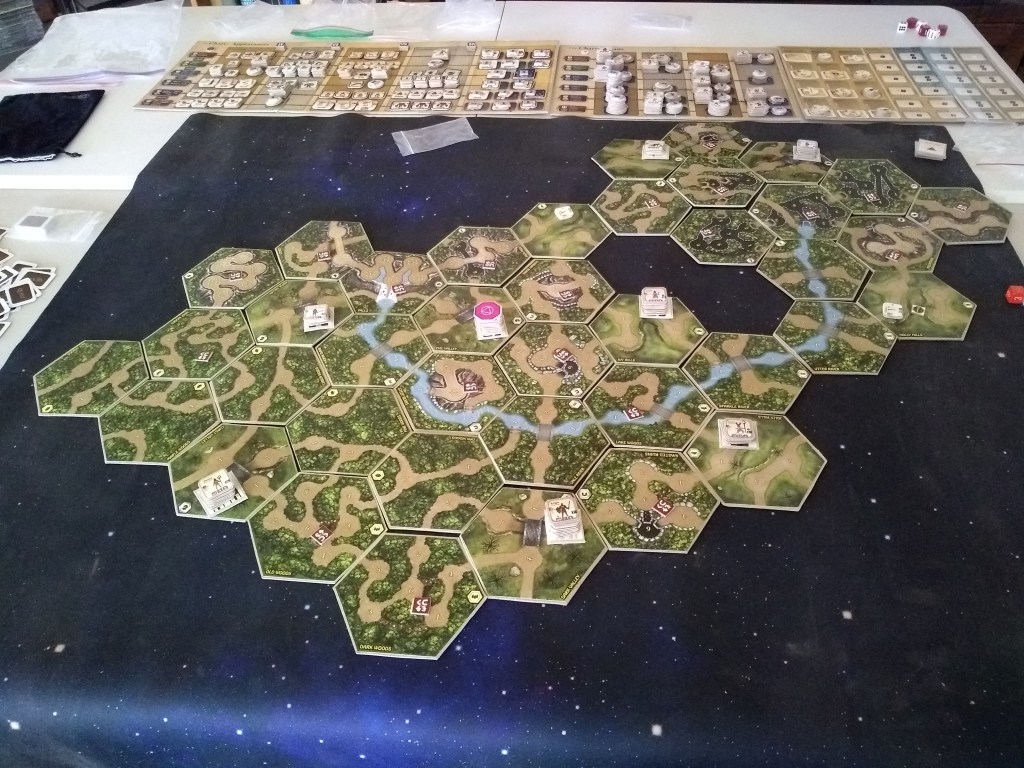
The biggest issue is the expanded size of the game, particularly the map size. I’m not talking about real-estate, though that should be a given. Don’t get me wrong, bigger is normally better. And the in-game world will definitely not feel too small (MR will feel too small after playing SMR once). But it can take longer for things to happen. Things in this game don’t really start to get interesting until at least one good site is revealed, usually the Hoard, Lair, Pit, Cairns, or Pool (roughly a quarter of all the sites in the game, which rounds out to about 1/8th of all the map chits). Because looting treasures, getting stronger as a result and/or having the potential to sell them off to raise an army that you can kill more stuff with, including other characters, things can get quite interesting once the looting begins. Considering the larger map and larger amount of sites (most with less overall treasures), it’s less likely for this to occur anytime soon, especially compared to MR. Once gain, this can be offset by games with a higher player count, high enough to where there’s at least 2 separate parties wandering the map (7+ players on-average, excluding certain characters that work better in isolation, like the Druid). Because the more parties/players there are, the faster things will be revealed on the map, which will increase the likelihood of interesting things (that will be of interest to most, if not all, players) happening earlier in the game.

There’s also those mission/campaign/visitor/task chits. They still feel a bit tacked on, even if it’s less so than in MR. Honestly, they tend to exist for games that run for long durations, at least 2 full game-months if not longer. Games that run for that long make those chits more appealing for picking up and exploiting to get some kind of edge when you need more VPs. The problem is that games don’t tend to run for that long. I’ve never played a session that ran longer than 2 months. On the other hand, I’ve never played a session that had more than 6 players. I imagine circumstances change when there’s more characters in the game running around doing their own killing and looting, which splits up opportunities for VP gain to the point where those chits become attractive prospects, or even necessary ones out of desperation (depending on the circumstances and where they are located). At least they come out more frequently compared to the base game, which is a good thing. The major downside to this is that, in order to benefit from these chits, the game would have to be a long one with a high player count (8+). Considering the game length averages at about 1-2 hours per experienced player (not including setup and takedown), this would probably be a weekend game session. Getting that to happen in this day and age would be rather difficult unless your one of those retired war vets who spends 4 days at a con playing some epic wargame that could potentially run for an entire month (real-time). But players of that age tend to go more for train or war simulation games, so you’re unlikely to find one interested in a fantasy setting.

Regarding the characters in the game. They each have their uses, and can be fun to play under the right circumstances. However, this is greatly dependent on what other players choose. There needs to be at least one heavy character, minimum (aside from the Gladiator), who is at least capable of killing just about everything. Then a couple Medium warrior characters, maybe a Light warrior character for good measure. At this point, some solid offensive magic users would be in order, like the Sorceror, or Witch King. If 6 players are involved in the game who have at least those types of characters distributed among them, the game is likely to be an interesting experience. If they don’t have those types of characters chosen, it becomes less likely for the experience to be optimal. So knowledge and experience is necessary to know about this sort of thing. If 6 players have those chosen, then each player added to the game from that point can amplify the experience regardless of what character is chosen from that point onward. The problem is getting to that player count with a game like this, which was a nigh impossible task with just the base game.
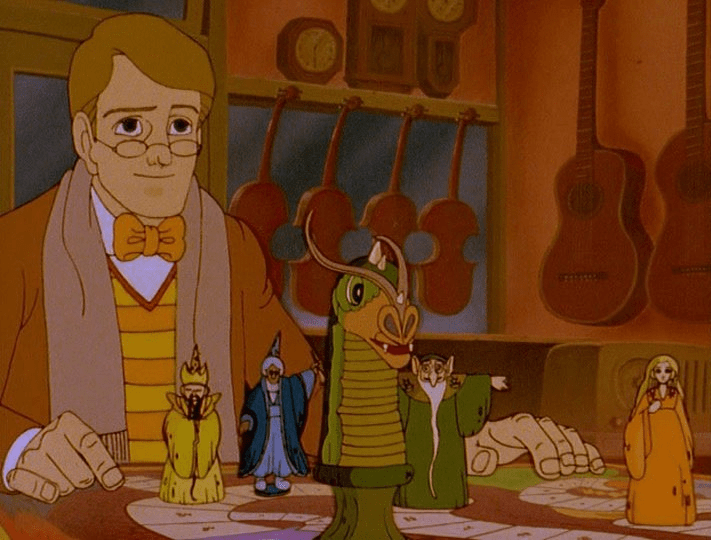
The game is very rewarding once the right type and sized group is playing it. But most board gamers these days don’t have the time or patience to learn and commit to playing something like this. But this game does have aspects to it that other board games to this day don’t (at least not in an adequate fashion). It is far less restrictive than most when it comes to the decisions players can make and the things they can get their characters to do, and the number of circumstances they can see themselves and others put into. It makes it almost feel like an open sandbox RPG, except its not. But because it can almost feel that immersive, well that’s just one thing it has going for it. That, and the amount of things it can make you think about in order to win, from the statistics of what could happen (the more you play, the better you can gauge your odds on certain things, let alone learning character strategies), to how you can utilize your character’s abilities (and treasures/spells when you get them) in order to negotiate with the other players/characters. There is a lot going on in this game, and even more when more players are involved in the fray.
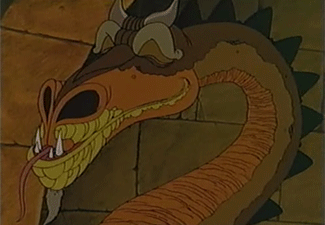
It’s a niche game because of what is required to get this experience out of the game, and it’s destined to remain a niche game for niche board gamers. And to that I say, “Good!” Because too many games these days get compromised/streamlined for the sake of a wider audience, and with a wider audience comes a greater chance of playing with imbeciles and flakes who stick to one game like a fad until its worn out after a few months (if not weeks, or just after one play) before moving on to the next fad equivalent. (Super) Magic Realm, if nothing else, is anything but a fad game. Fad games come and go, and eventually become forgotten (for the most part), unless it manages to become a classic like Monopoly and Risk. But cult classics that defy being a fad, those are a special breed of board games. They live and die by the players who play them and preserve them, or in some cases expand them. Sometimes this results in a glorified remake that tweaks a few things here and there (from gameplay to setting), like Rex: Final Days of an Empire was to Dune. Sometimes this results in the game miraculously getting a reprint (like Dune, which ended up outlasting the very game that was a remake of it). But sometimes, due to how niche and anti-mainstream (and involved in weird copyright conundrums) a game is, the fanbase is all it will ever have going for it.

As part of the fanbase, I did my part. The question is if you think it’s worth the effort to try this out. I must emphasize, it’s not for everyone. Hell, it better not be, there’s plenty of people out there I wouldn’t want to play this game with (let alone want to play with in general). But if this seems like something your gaming group could get into, if they’re hardcore enough and dedicated enough and willing to put up with some frustrations regarding dice results (that’s par for the course for just about any game made prior to 2005), and are interested in a board game fantasy experience that almost feels like a sandbox RPG… Well I can say I haven’t experienced any that can top this.



Always a pleasure to see some using imagery from The Flight of Dragons!
LikeLiked by 1 person
Well of course. Considering that movie actually says the words, “Magic Realm,” and has characters and spells that seem ripped straight out of this game, how could I not incorporate it?
LikeLiked by 1 person
Haha…very true!!!
LikeLike